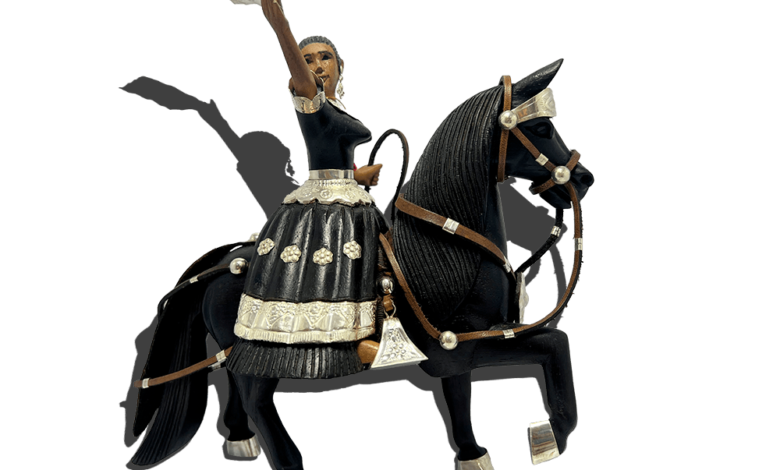Marinera con Caballo de Paso Fondo Blanco: The Cultural Gem of Peru

Introduction
The “Marinera con Caballo de Paso Fondo Blanco” is a vibrant symbol of Peruvian culture, combining the elegance of the Marinera dance and the beauty of the Peruvian Paso horse. This cultural tradition is deeply rooted in the history of Peru, embodying centuries of passion, skill, and pride. The blend of the graceful movements of the Marinera dance, performed by a female dancer, and the rhythmic, smooth gait of the Paso horse creates a visual spectacle that is loved and cherished by many. This article will dive deep into the rich history and importance of the “Marinera con Caballo de Paso,” its role in Peruvian heritage, and how it continues to capture the hearts of spectators both locally and internationally.
A Brief History of Marinera and Peruvian Paso Horse
The Marinera Dance
The Marinera is a traditional dance of Peru, known for its romantic and playful nature. It is often considered a flirtatious dance, where a man and woman court each other with intricate footwork and the waving of handkerchiefs. This dance style evolved from the Spanish “fandango” and other European dances introduced to South America during the colonial era, mixing with the rhythms and styles of indigenous and African populations to form something uniquely Peruvian.
The Marinera has different variations across the regions of Peru, with the northern Marinera being the most famous. The coastal version, known as “Marinera Limeña,” has a more stylized and elegant movement, while the northern style is more robust and energetic. Regardless of the region, the dance is celebrated for its elegance and the way it tells a story of love and courtship.
The Peruvian Paso Horse
The Peruvian Paso horse is a breed known for its smooth gait, which is described as “paso llano.” It is often referred to as the world’s most comfortable riding horse because of this natural gait, which makes it ideal for long rides without tiring the rider. Bred and perfected in Peru, the Paso horse is not only valued for its comfort but also for its grace and beauty.
These horses are descendants of the Spanish horses brought by conquistadors in the 16th century, specifically Andalusians, Barbs, and Jennets. Over time, through selective breeding in the coastal plains and mountains of Peru, the Paso horse developed a unique gait that distinguishes it from other horse breeds worldwide.
The Perfect Combination: Marinera con Caballo de Paso
When the grace of the Marinera dance is combined with the smooth movements of the Peruvian Paso horse, the result is an extraordinary spectacle. The “Marinera con Caballo de Paso Fondo Blanco” is not just a dance performance—it’s a vivid expression of Peruvian heritage. The horse and the female dancer synchronize their movements to the rhythm of the music, creating a dynamic visual narrative of courtship and celebration.
The female dancer performs on foot, her movements precise and fluid, while the male rider skillfully guides the horse, mimicking the steps of the dance. The horse’s smooth and graceful gait is essential to the performance, as it harmonizes with the dancer’s delicate footwork.
This combination showcases not only the skill of the dancer and rider but also the bond between the horse and human. The Paso horse plays a critical role in the dance, adding a layer of complexity and elegance to the performance. As a result, the “Marinera con Caballo de Paso” has become a key cultural event in Peru, celebrated during festivals and competitions.
Cultural Significance of Marinera con Caballo de Paso Fondo Blanco
A National Icon
The “Marinera con Caballo de Paso” is much more than an artistic performance; it is a national icon of Peru. It reflects the country’s diverse heritage, blending indigenous, African, and Spanish influences. Both the dance and the horse are considered cultural treasures, symbolizing the pride and history of the Peruvian people.
This tradition is often showcased during national holidays, including Peru’s Independence Day celebrations. It is also a central feature at horse shows and festivals, where both the dancer and the horse are adorned in traditional attire, adding a sense of pageantry and pride to the event.
Social and Economic Impact
Beyond its cultural value, the “Marinera con Caballo de Paso Fondo Blanco” also has significant social and economic importance. The breeding and training of Peruvian Paso horses is a thriving industry, with breeders dedicated to preserving the purity of the breed. Competitions and festivals featuring these horses draw large crowds, boosting tourism and providing economic opportunities for those involved in the breeding, training, and performance sectors.
Many families take great pride in their horses, passing down breeding techniques and traditions from generation to generation. These horses are a source of pride, not just for their beauty and grace but for their contribution to Peru’s cultural heritage and economy.
The Role of “Fondo Blanco” in the Performance
The term “Fondo Blanco” refers to the plain white background often used during performances of “Marinera con Caballo de Paso.” This choice of background is significant for several reasons. First, it allows the focus to remain solely on the performers—the dancer, the rider, and the horse. The simplicity of the white background eliminates distractions, making the elegant movements and skill of the participants the central point of attention.
Moreover, the “Fondo Blanco” adds a sense of purity and timelessness to the performance. It evokes a feeling of tradition, as if the dance and the horse’s movements transcend time, connecting the present to Peru’s rich cultural past.
Why Marinera con Caballo de Paso Fondo Blanco Endures
The endurance of the “Marinera con Caballo de Paso Fondo Blanco” tradition can be attributed to several factors. Its beauty and elegance captivate audiences, while its cultural significance ensures that it remains a beloved part of Peru’s heritage. The dance and horse breed represent the blending of different cultural elements, making it a unique expression of Peruvian identity.
Additionally, the role of competitions, festivals, and tourism has helped to keep this tradition alive. Breeders and trainers continue to invest in preserving the Paso horse’s unique qualities, while dancers and riders perfect their craft to ensure that each performance is a memorable one.
Final Thoughts
The “Marinera con Caballo de Paso Fondo Blanco” is a living testament to Peru’s cultural richness. Combining the elegant Marinera dance with the smooth, graceful movements of the Peruvian Paso horse creates a performance that mesmerizes audiences. It reflects the heart and soul of Peru, blending tradition, artistry, and history into a singular cultural experience.
As Peru continues to celebrate its heritage, the “Marinera con Caballo de Paso” will undoubtedly remain an essential part of its national identity. Whether seen at a festival, a competition, or a grand cultural event, this performance will continue to captivate new generations of spectators.
Questions and Answers
Q: What is the Marinera con Caballo de Paso Fondo Blanco?
A: It is a traditional Peruvian cultural performance that combines the Marinera dance with the Peruvian Paso horse, often performed against a plain white background to highlight the skill of both the dancer and the horse.
Q: Why is the Peruvian Paso horse special in this tradition?
A: The Peruvian Paso horse is renowned for its smooth gait, which complements the graceful movements of the Marinera dancer, making the horse an integral part of the performance.
Q: What does “Fondo Blanco” signify in these performances?
A: “Fondo Blanco” refers to the plain white background used in the performance, which helps to focus attention on the dancers and horses, emphasizing their movements and skills.
Q: Why is the Marinera con Caballo de Paso significant in Peruvian culture?
A: It represents a blend of indigenous, African, and Spanish influences in Peruvian history, making it a symbol of national pride and cultural heritage.
Q: Are there competitions or festivals that feature this performance?
A: Yes, the “Marinera con Caballo de Paso” is often showcased at cultural festivals, national holidays, and horse shows, attracting large audiences and contributing to Peru’s tourism and economy.




